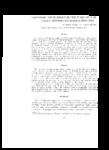Ensayo sobre control químico del tizón de halo del frijol causado por Pseudomonas phaseolicola (BURK) Dows

View/
Date
1968Author
Izquierdo Luna, Medardo
Téliz Ortíz, Moisés
Metadata
Show full item recordAbstract
Se estudió la posibilidad de controlar el "tizón de halo" del frijol en el campo por aspersiones de Agrimicina 100, Sulfato de Dihidroestreptomicina y caldo bordelés, solo y mezclado con los antibióticos. Las plantas provinieron de semilla inoculada por inmersión en una suspensión acuosa del patógeno Pseudomonas phaseolicola. Los testigos no asperjados con los bactericidas resultaron altamente infectados. Se encontraron diferencias significativas entre tratamientos respecto al peso promedio por planta, total de ejote y ejotes comerciales. Según la prueba de Duncan, los mejores tratamientos fueron Agrimicina (500 ppm) y caldo bordelés. In vitro, el caldo bordelés causó la mayor inhibición del patógeno. Se verificó la translocación ascendente de los antibióticos. Aunque con leves efectos fitotóxicos, la efectividad de los antibióticos en el campo fue evidente. El caldo bordelés, con resultados iguales o superiores a los antibióticos, podría recomendarse por su bajo costo, contra el tizón de halo. Queda pendiente determinar el máximo de aspersiones necesarias y la época adecuada de su aplicación para recomendaciones prácticas. ABSTRACT: The possibilities of controling halo blight of beans were studied under field conditions spraying with Agromycin 100, streptomycin sulphate and Bordeaus mixture alone, and mixed with the antibiotics. Bean plants were obtained from seeds inoculated by inmmersion in a water suspension of the pathogen, Pseudomonas phaseolicola. Check plants not sprayed with the chemicals, resulted highly infected. Significant differences were found among treatments in relation to average plant weight, total pod number and number of commercial pods. Using Duncan's procedure the best treatments were agromycin (500 ppm) and Bordeaux mixture In vitro, Bordeaux mixture caused the greatest inhibition of the pathogen. Upward movement of the antibiotics inside of plants was verified. Even with slight phytotoxic effects, the effectivity of the antibiotics was evident. Bordeaux mixture, with results similar or superior to those obtained with antibiotics, could be recommended against halo blight, because of its low cost. The minimum number of sprays and the right time to apply them for practical recomendations is still to be determined.
Collections
- Agrociencia [55]
